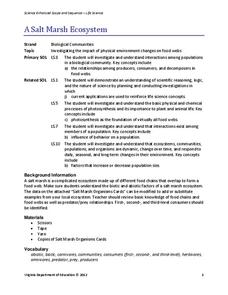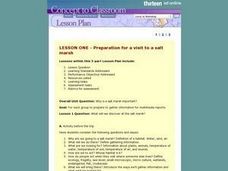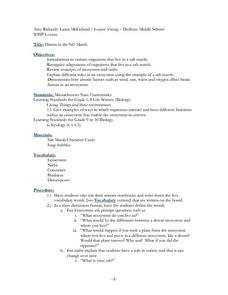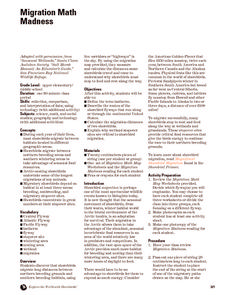Virginia Department of Education
A Salt Marsh Ecosystem
What a web we weave. Pupils use yarn as the primary resource to create a web depicting the intricacies of a salt marsh ecosystem. They participate in a question and answer session, which leads to an in-depth facilitated discussion about...
Curated OER
Salt Marsh in a Pan
Students create a model of a salt marsh to discover the impact of pollution and human activities on water-based habitats including bays and the ocean. They recognize the relationship between natural and developed areas. Students impact...
Curated OER
Why is a salt marsh important?
Students discuss the salt marsh. They define the following terms: habitat, water, land and air. Students work in small groups. They are asked why are they going to a salt marsh? Students discuss whose habitat is it at the salt marsh.
Curated OER
Salt Marshes And Their Inhabitants
Students investigate the ecosystem of the salt marshes. This is done in order to develop an appreciation for this type of environment. They conduct research using a variety of resources. Students are given samples of different organisms...
Curated OER
Who Eats Whom in the Salt Marsh?
Seventh graders complete a virtual online salt marsh tour. In groups, they observe and identify the various types of animals found in the marsh. After categorizing the animals, they create a food web based on the animals role in the...
Curated OER
Visit the Salt Marsh
Students visit the salt marsh. They work in groups to answer questions on their worksheets. Students also work in groups to collect information. They are given an introduction to the salt marsh. Students properly store and label...
Georgian Court University
Introduction to Marsh Ecology
Compare and contrast the characteristics of fresh and salt water marshes. After exploring the typical plants and animals found in each marsh type, participants use a set of flash cards to sort into fresh and salt water marsh life. Their...
Curated OER
Marine Habitats of Galveston Island
Four lessons introduce elementary ecologists to salt marsh and sandy beach habitats. In the first lesson plan, they place shells and other materials in vinegar to determine if they contain calcium carbonate. In the second lesson plan,...
Curated OER
Changing With the Tide
Young scholars describe three different aspects or life forms of the salt marsh. They compare and contrast the low and high marsh. Students explain what happens in different areas of the marsh at low and high tide; and explain the roles...
Curated OER
Changing With the Tide
Students research and they role-play the behavior of plants and animals in a salt marsh habitat as the tides change.
Curated OER
Drama in the Salt Marsh
Middle schoolers are introduced to the various organisms that live in a salt marsh. They recognize adaptations of organisms that live in the salt marsh. Pupils review concepts of the ecosystem and niche. Students explain the different...
Curated OER
The Marsh Land as a Changing Environment
Sixth graders continue their examination of the state of Connecticut. After taking a field trip, they identify the types of birds, plants, invertebrates and vertebrates who make their home in the salt marshes. In groups, they identify...
Curated OER
Salt is Good On Sunflower Seeds, But What About Cypress?
Students record their observations about growing a cypress plant and putting salt in the plant. In this cypress plant lesson plan, students observe and record what is happening as the cypress plant grows. This gives directions for...
Curated OER
Wetlands and Saltmarshes
Students identify the different functions of a wetland system and why the system is important to the St. Mary's River ecosystem and the environment. They play a migration game and write a journal about the salt marsh periwinkle and how...
Curated OER
Brine Shrimp Survival
Students develop an understanding of how growth and survival of an organism depends on physical conditions. They design an artificial environment in which brine shrimp can thrive. Students determine the optimum salinity for hatching of...
Curated OER
Oysters Are Habit Forming!
Students examine the relationships within a salt marsh habitat. In this habitat lesson, students examine the various kinds of symbiotic relationships in a salt marsh habitat.
Georgia Aquarium
The Ocean's Nursery
Linear perspective, estuaries, and water ways converge in a science-inspired art project. The class uses what they've learned about eco-systems, estuaries, and the food chain to create scale models of a local marsh. While the lesson is...
Curated OER
Sea Level and the Terrapin
Students study the habitat of the terrapin. In this terrapin lesson plan, students create a diorama of the habitat of the terrapin. Students also simulate how it would look if people moved into the area and how predators can threaten...
Curated OER
Salty Solutions
Students measure salt content in water. They determine salt content of four samples using a hydrometer.
Curated OER
Phragmites australis: Invasive Plant Species
Students research and investigate invasive species, with specific focus on the exotic plant Phargmites australis and its impact on Piermont Marsh near the community of Piermont, New York.
Curated OER
UMNH: Cultural Clutter - Tales In The Trash
Fourth graders list three or more types of evidence of prehistoric cultures that encouraged archaeologists to investigate the marshes around the Great Salt Lake. They also explain why it is important not to disturb archaeological remains.
Prince William Network
Migration Math Madness
A great way to incorporate math into life science, this instructional activity has learners measure migratory routes on a map and calculate the actual distance that shorebirds on the routes would cover. Learners compute the distance...
Curated OER
Related Lessons Animal
Learners examine the extinction of dinosaurs. In this dinosaur lesson students create their own dinosaur eggs, get into groups and complete a diorama activity.
Curated OER
Earth Science
Students analyze the mechanisms for generating ocean currents, temperature, and deep ocean circulation. They are able to assess the formation and breaking of waves and their effect on shorelines, particularly the North Carolina coast. ...
Other popular searches
- Salt Marsh Decomposer
- Salt Marsh Organisms
- <I>a Day in the Salt Marsh</i>
- Salt Marsh Ecology
- The Salt Marsh
- Salt Marshes Stad
- Salt Marshes Temperature
- Salt Marsh Decompose
- Food Web Salt Marsh
- Salt Marsh Metaphors
- Salt Marsh and Humans
- A Day in the Salt Marsh

























